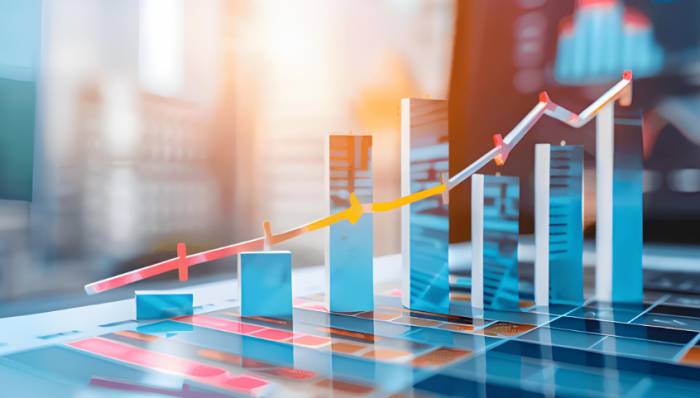Nasdaq Hits New Heights, French Stocks Rise
The recent political turmoil in South Korea has ignited a wave of global market reactions, underscoring the interconnected nature of the world economy. President Yoon Suk-yeol's late-night announcement of a "state of emergency" triggered immediate volatility across various financial markets, reflecting investor fears and a flight towards safer assets. During this time, the South Korean won experienced a sharp decline, plummeting by as much as 2.7% against the US dollar, reaching a two-year low at the height of the crisis. However, a rapid move by the South Korean parliament to revoke the emergency declaration helped stabilize the currency, with the Financial Ministry and central bank contemplating market support measures to mitigate the fallout.
This political drama in South Korea coincides with intense focus on the economic landscape in the United States. The JOLTS job openings data for October showed a rebound exceeding expectations, which has led the Federal Reserve to adopt a more cautious stance on future interest rate cuts. Investors are now eagerly awaiting upcoming reports, including a key employment report and remarks from Fed Chairman Jerome Powell, to gauge the potential for rate adjustments.
In a notable development, the chair of the San Francisco Federal Reserve, Mary Daly, hinted at the possibility of rate cuts in December, echoing sentiments from fellow Fed officials about adopting a more measured approach to policy decisions. Traders currently estimate a 70.3% likelihood of a 25 basis point rate cut in December, influenced by ongoing discussions about inflation and growth.
Advertisement
The initial negative impacts of the South Korean emergency declaration were evident in the US market as fear gripped investors, momentarily causing declines across major indices. The Nasdaq composite dipped as much as 0.3%, and the Dow Jones Industrial Average saw a drop exceeding 200 points. However, following the lifting of the emergency and announcements from South Korean officials, recovery ensued, leading to a narrowing of losses by the market close.
Despite the minor fluctuations, the broader picture reveals resilience, particularly as the S&P 500 index marked its 55th closing high of the year. The overnight developments also impacted exchange-traded funds linked to South Korea, such as the iShares MSCI South Korea ETF, which initially fell over 7% before recovering slightly by the end of the session.
Sector performances varied, with key economic indicators revealing a mix of gains and losses within different industries. While the biotechnology index ETF fell by 1.22%, technology shares saw upward movement with notable increases from giants such as Meta and Amazon, which reacted positively to consumer sales forecasts as the holiday shopping season approached.
The cyclical nature of the market left traders vigilant as they closely monitored the shifting dynamics in the tech sector, particularly the "Magnificent Seven" — a term used to describe leading tech companies like Apple and Microsoft. Interestingly, Apple reached new closing highs after consistent gains over several trading days, whereas Tesla faced challenges, particularly following revelations connecting CEO Elon Musk's compensation package—a matter currently challenging in the courts.
The semiconductor sector exhibited variance in performance. While some companies recorded gains, Intel struggled significantly, with shares plummeting by 6.1% as the firm searched for a new CEO and engaged with potential candidates from within the industry. Conversely, TSMC and Micron Technology saw their stocks advance amidst broader optimism about future tech developments.
Meanwhile, developments in the AI sector showcased another layer of complexity, with mixed outcomes among key players in this rapidly evolving field. Stocks such as Palantir and BigBear.ai exhibited robust gains, whereas companies like Dell and SoundHound experienced declines. This sector remains a focal point for investors keen on capitalizing on growth opportunities.
On the international front, European equities reflected similar sentiments as investors watched the political landscape in France, with a confidence vote looming over the government of Prime Minister Barnier, potentially signaling instability. France's stock market saw activity fluctuate, but ultimately closed in the green, showcasing a resilience amid political uncertainty.
The pan-European STOXX 600 Index also rose, reinforcing the perception of a market gaining momentum, albeit with underlying caution regarding looming geopolitical strife. As UBS noted in their assessment, global investors are increasingly wary of European equities, particularly amid fears related to France and Germany’s economic outlook.

In the commodities market, investors reacted to geopolitical sensitivities that once again surfed the waves of oil prices, spurred in part by potential supply curtailments from OPEC+ as they contemplate delaying production increases. This resulted in crude oil prices rallying significantly over the close, reinforcing perceptions of tight market conditions ahead.
Gold, often a safe haven asset, initially saw an uptick amidst the recent political anxieties but then tempered its gains as market traders shifted focus back toward US economic indicators that demonstrated resilience in job availability. However, the precious metal was still buoyed by instances of volatility linked to ongoing global tensions.
While the evolving situation in South Korea continues to pose risks, analysts posit that broader stock markets might find footing amidst supportive central bank narratives and an improving economic outlook. Thus, as these developments unfold, market participants remain engaged, armed with the insights necessary to navigate a complex landscape influenced by both domestic and international factors.
These dynamics underscore a critical narrative in today's markets—politics and economics are inextricably linked, where decisions taken in one part of the world can ripple through to others, showcasing the importance of vigilance and adaptability in investment strategies.